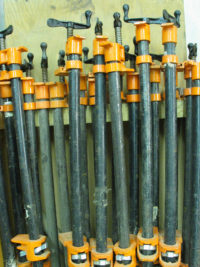Clamping Pressure on glued joints.
So, let’s review the role of pressure in gluing. A glue joint should be 0.002 to 0.006 inch thick for maximum strength. Obviously, this preciseness requires very flat surfaces, especially for the denser wood species that do not compress easily. Flat surfaces mean perfect surface proportion, plus we need to apply the glue before the surfaces have a chance to pick up moisture from the air (if the are a bit dry, such as in the summertime) or lose moisture if they are a bit wet (true in the dry wintertime air). If the wood surfaces change MC, they will swell or shrink a little bit, but this can make the 0.002 to 0.006 inch impossible to attain along the entire joint. Obviously, the surfaces cannot be dirty, or burnished from saw heating, etc.
Now here is something that you may not have thought about. In the wintertime, the plant is cooler than in the summer. The glue itself, if the plant is really cool at night, will be really cool in the morning. And on those hot summer days, the glue will be really thin. So, it should make sense that it will take a little more effort (pressure) to squeeze out the glue in the wintertime than in the summertime. So, think about using two different pressures. It might also be prudent to think about storing the glue at a constant temperature year-round.
So, how much pressure? The starting guide is the glue manufacturer and your clamp manufacturer. We always want to see good squeezeout along the joint. Then after the joint is cured, with a small magnifying glass (15 or 20X) you can examine the dried joint and determine or estimate its thickness. Make sure you check multiple locations along the joint’s length.

